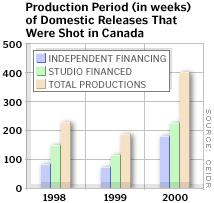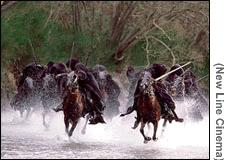
NEW YORK (CNN/Money) -
It is home to many of the world's top movie studios, but a recent study shows the film production business is heading elsewhere, and that's becoming a real economic worry for California, particularly Southern California.
The Center for Entertainment Industry Data and Research (CEIDR) reported that Canada, for example, received 26 percent of overall production of U.S.-financed film projects in 2000, twice that of the year before. The number of major films with budgets exceeding $50 million shot in Canada also rose to five in 2000 from just one in 1999, the CEIDR study said.
And there are more signs of trouble. Location shooting for feature-length films in Los Angeles in 2001 was just half the 1995 level, the report said, claiming the shift has resulted in a loss of nearly 23,000 film jobs. The U.S. employment rate in the industry has reached a four-year low.
Separately, the trade paper Daily Variety reported that an estimated $10 billion worth of direct expenditures on U.S. film and television production has been lost to Canada every year since 1998 - the same year the Canadian government passed the Canadian Production Service Tax Credits, which rebate up to 30 percent of production costs.
Tough times in Tinseltown
Jennifer Dubin, a 27-year-old filmmaker who moved to Los Angeles more than two years ago to work where movies are made, said the migration has diminished job opportunities for many in Southern California, and signs of trouble loom everywhere.

"It's always a tough job market," said Dubin, who recently found a full-time job at a small film company in L.A. after she freelanced for several production companies. "But I think more people are looking and out of work."
Jack Kyser, chief economist at the Los Angeles Economic Development Corp., said Hollywood had a "strike against commercial producers [in 2000] and the threat of a strike by writers and actors last year. It really depressed activity."
But, he added, the issue of "runaway" production tops the list of Tinseltown's frustrations.
Stephen Katz, co-founder of CEIDR, said it is becoming more common for U.S. filmmakers to assume their films will be shot in Canada, considering the budgets.
Kyser agreed. He said various film studios across the country have reduced their funding significantly, and the weak Canadian dollar and cheaper labor costs make filming in Canada "very attractive."

Directions other than North
Two of this year's hottest Oscar contenders, "The Lord of the Rings: The Fellowship of the Ring" and "Moulin Rouge," were filmed and produced entirely in New Zealand and Australia, respectively.
Mark Ordesky, executive producer of "Lord," said "the problem in this process is self-policing."
 |
|
| New Line Cinema spent $270 million to make the "Lord of the Rings" trilogy. |
'Film studios are always looking for ways to save money, and it would cost dramatically more if the film [Lord] wasn't shot overseas," he said.
But CEIDR's Katz argued that while the bottom line remains crucial, many film companies have compromised the creative and artistic merits of the film.
"This is a creative field," Katz argued. "There's quality and there's quantity, and there's cheap goods."
Katz said Hollywood has dominated the industry for a long time, and a shortage of experienced crew, especially in highly skilled areas, often inconveniences runaway production.

Ordesky defended the decision by saying that New Zealand was the perfect location for J.R.R. Tolkien's "Lord" trilogy. "In order to sustain the belief, the geography of the film has to look like Middle Earth," he said.
As for "Moulin Rouge," a Paris-based love story about "truth, beauty, freedom, above all," it was shot completely in a sound studio in Sydney, Australia.
Katz said the Australian government subsidized a great deal of tax incentives for Twentieth Century Fox, the studio that financed "Moulin Rouge," and New Line Cinema received similar benefits for the "Lord" trilogy from the New Zealand government.
Both New Line and CNN/Money are subsidiaries of AOL Time Warner (AOL: Research, Estimates).
When will this end?
In January, California Gov. Gray Davis proposed a tax break that would grant film studios a 15 percent tax credit if the filming location is within California. But if passed, the plan would not take effect until 2004.
Katz said a tax incentive would not be a wise solution for the state. He argued that if California offers those "runaway" productions a tax rebate, then the same deal would have to be extended to the remaining film productions, which currently still hold a majority.
Studios and Hollywood unions also are discussing ways of putting the brakes on runaway productions, possibly including contract concessions.
But there's no official word yet on concessions, and speculation so far has focused on made-for-TV movies and new series, according to Daily Variety.
Katz said the U.S. has a 100-year reputation and legacy as the leader in the industry, but as countries throughout the world increasingly understand the potential value of the industry to their economies, "We can expect them to take more aggressive measures to better their positions in the industry."
"There are always ways to save money," he added. "But this will always be the home to many of the world's best artisans and crafts persons."

|

